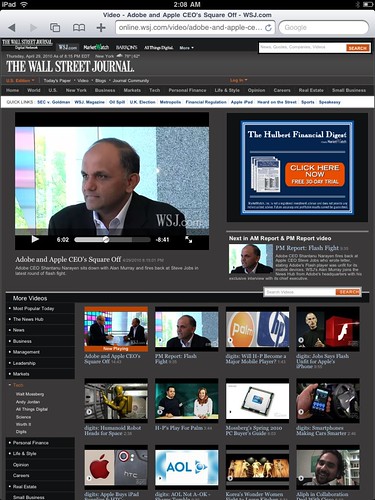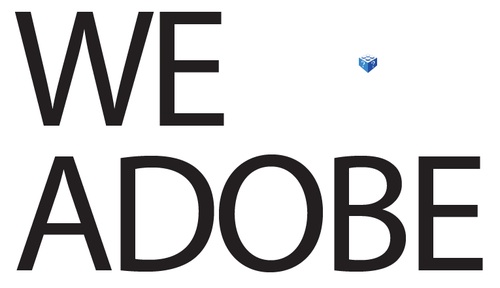Wie verhält es sich denn hier mit dem Prozentsatz an mobilen Usern auf der Seite. Über oder unter 5%?
Adobe und Flash
- Thread starter chrizel
- Start date
-
PSN-Name: l-Cristo-l
Also unter 5%. Das heisst doch, dass sich gerade kommerzielle Webseiten im Moment noch keinen Kopf machen müssen, unfassbare Einbußen zu haben, wenn sie auf Flash setzen.
Vor allem wenn man bedenkt, dass sich hier überdurchschnittlich viele Apple User tummeln. Finde ich jedenfalls. Ich denke einen höheren Anteil findet man sonst nur bei Apfeltalk
Liegt vielleicht auch an der Art der Seite. Ich glaube, das Playstation-liebende eher zu einem Apple Gerät greifen, als X-Box User. Denn das ist mMn in gewissen Zügen auch eine Stilfrage.
Die Aussage, das Flash auf mobilen Geräten momentan tot ist, stimmt wohl.
Aber ich würde lediglich behaupten, "dass Flash auf mobilen Geräten" noch nicht angekommen ist. Entsprechende Ankündigungen gibt es ja bereits.
Mal schauen.
Und ich wiederhole mich zwar nur ungern, aber wie bereits erwähnt, wird HTML5 Flash erst anfangen abzulösen, sobald alle Browser dies unterstützen. Darauf würde ich jedenfalls mein Geld wetten.
Denn dann ist es für Otto-Normal Surfer bequemer einfach den Browser zu installieren und loszulegen, als sich vorher noch das Flash-Plugin zu besorgen.
Die Zeit wird es zeigen.
Vor allem wenn man bedenkt, dass sich hier überdurchschnittlich viele Apple User tummeln. Finde ich jedenfalls. Ich denke einen höheren Anteil findet man sonst nur bei Apfeltalk
Liegt vielleicht auch an der Art der Seite. Ich glaube, das Playstation-liebende eher zu einem Apple Gerät greifen, als X-Box User. Denn das ist mMn in gewissen Zügen auch eine Stilfrage.
Die Aussage, das Flash auf mobilen Geräten momentan tot ist, stimmt wohl.
Aber ich würde lediglich behaupten, "dass Flash auf mobilen Geräten" noch nicht angekommen ist. Entsprechende Ankündigungen gibt es ja bereits.
Mal schauen.
Und ich wiederhole mich zwar nur ungern, aber wie bereits erwähnt, wird HTML5 Flash erst anfangen abzulösen, sobald alle Browser dies unterstützen. Darauf würde ich jedenfalls mein Geld wetten.
Denn dann ist es für Otto-Normal Surfer bequemer einfach den Browser zu installieren und loszulegen, als sich vorher noch das Flash-Plugin zu besorgen.
Die Zeit wird es zeigen.
Zuletzt editiert:
Um noch einmal auf die Marktanteile zu kommen, ich halte beide Varianten, die von Apple und die Admob-Darstellung für Schwachsinn. Beide sind sehr geschönt für den jeweiligen Zweck. Bei AdMob z.B. tauchen viele iPhones usw. gar nicht erst auf, weil die ganzen Zugriffe über Apps dort gar nicht registriert werden und auch viele andere Zugriffe keinen Admob-Hit auslösen.
Jedenfalls ist auf das Gesamtnetz der Anteil beider noch sehr gering. Die Frage ist, wie wichtig sind die Mobil-Zugriffe im Vergleich? Was würde passieren wenn man große Downloads nicht berücksichtigen würde usw.
Von daher sollte man wohl Mobil-Zugriffe und andere als zwei Marktsegmente sehen.
Ich habe noch eine andere allgemeinere Netzstatistik gefunden, wo sogar das iPad schon auftaucht:
http://marketshare.hitslink.com/operating-system-market-share.aspx?qprid=8
iPhone, iPod, iPad zusammen: 0,68%
Android: 0,09%
Im Vergleich zu Admob ist hier Android also unter ferner liefen und noch sehr weit hinter iPhone & Co. Allerdings hat Android Windows Mobile schon deutlich überholt, das hat nur noch 0,06%. Symbian dagegen ist mit 0,23% noch sehr stark. Insgesamt scheinen mir diese Zahlen recht plausibel.
Jedenfalls ist auf das Gesamtnetz der Anteil beider noch sehr gering. Die Frage ist, wie wichtig sind die Mobil-Zugriffe im Vergleich? Was würde passieren wenn man große Downloads nicht berücksichtigen würde usw.
Von daher sollte man wohl Mobil-Zugriffe und andere als zwei Marktsegmente sehen.
Ich habe noch eine andere allgemeinere Netzstatistik gefunden, wo sogar das iPad schon auftaucht:
http://marketshare.hitslink.com/operating-system-market-share.aspx?qprid=8
iPhone, iPod, iPad zusammen: 0,68%
Android: 0,09%
Im Vergleich zu Admob ist hier Android also unter ferner liefen und noch sehr weit hinter iPhone & Co. Allerdings hat Android Windows Mobile schon deutlich überholt, das hat nur noch 0,06%. Symbian dagegen ist mit 0,23% noch sehr stark. Insgesamt scheinen mir diese Zahlen recht plausibel.
wtf -- Adobe macht eine "We Love Apple" Werbekampagne:
http://www.engadget.com/2010/05/13/adobe-targets-apple-in-ad-campaign-launched-today-publishes-ope/
http://blogs.adobe.com/jnack/files/AdobeAppleAd.pdf

http://www.engadget.com/2010/05/13/adobe-targets-apple-in-ad-campaign-launched-today-publishes-ope/
http://blogs.adobe.com/jnack/files/AdobeAppleAd.pdf

lol, ich frag mich jetzt wo deren Problem ist, liegts an dem Verbot des Cross Compiling oder an der normalen Flash Sache?
Warum Adobe Flash nicht einfach öffnet. Open Source. Verkaufen ja trotzdem noch ihre Dreamweaver.
Aber mich nervt Flash grad immer mehr. zB hängen sich YouTube Videos auf oder lassen sich nicht spulen. k.A. ich warte beständig auf das Update, dass auf dem Mac besser laufen soll.
Warum Adobe Flash nicht einfach öffnet. Open Source. Verkaufen ja trotzdem noch ihre Dreamweaver.
Aber mich nervt Flash grad immer mehr. zB hängen sich YouTube Videos auf oder lassen sich nicht spulen. k.A. ich warte beständig auf das Update, dass auf dem Mac besser laufen soll.
perfekter gehts nich:
"Dear Adobe, when the name of your "open" product contains two uses of ® then it isn't open. http://www.adobe.com/choice/"
"Dear Adobe, when the name of your "open" product contains two uses of ® then it isn't open. http://www.adobe.com/choice/"
"Adobe Flash: Almost as Open as Microsoft Office
Friday, 14 May 2010
“Open” is one of those terms that means a lot of different things to different people. Most should be able to agree, though, that open-vs.-closed is a continuum — shades of gray, not just black and white. A light enough shade of gray is “open”, dark enough is “closed”. The arguments are over where those thresholds lie.
I, for example, would argue that HTML5 is open, and that Flash is not. HTML5 is open, to my eyes, because no one vendor defines or controls either its specification or its numerous implementations. The specification is being written and decided upon by consensus by two standards groups, WHATWG and the W3C. There are critics of the HTML5 spec, as well as critics of the process used to create it and the power vested in WHATWG editor Ian Hickson. But you can’t please everybody. The bottom line is that all five of the top web browser makers — Microsoft, Mozilla, Google, Apple, and Opera — agree that HTML5 is an open spec. There’s not much you can get those five to agree upon.
Adobe’s argument that Flash is open larges hinges upon their having published a specification for the SWF file format, and that in May 2008, Adobe dropped the Macromedia-era licensing restriction forbidding the creation of software to play SWF content. The existence of this spec certainly makes SWF more open than if the spec did not exist. But open enough to qualify Flash as an open technology?
One argument against that would be that even a complete working implementation of everything in Adobe’s published spec would leave you with a Flash player that doesn’t work with much popular Flash content. As Christina Warren wrote yesterday at Mashable:
But let’s put that aside. I often find it a useful technique to concede a point for the sake of argument and see where that leads. So let’s concede that Flash is “open” because Adobe has published the partial SWF 10 file format spec.
Microsoft published the OOXML file format specs for its Office apps. And not only did the publish the specs, they submitted them to a widely-respected industry standards organization, and now they’re ISO standards.
Adobe’s Flash specs have never been submitted to standards body, let alone accepted, thus, anyone who argues that Adobe Flash is open would agree that Microsoft Office is even more open. ★"
---------- Beitrag um 01:48 Uhr hinzugefügt ---------- Vorheriger Beitrag um 01:06 Uhr ----------
und das für die lulz

"Me, using my iPad to watch a video from the WSJ of Adobe's CEO talking about how essential Flash is to publications like the WSJ."
http://www.flickr.com/photos/gruber/4564503719/
Friday, 14 May 2010
“Open” is one of those terms that means a lot of different things to different people. Most should be able to agree, though, that open-vs.-closed is a continuum — shades of gray, not just black and white. A light enough shade of gray is “open”, dark enough is “closed”. The arguments are over where those thresholds lie.
I, for example, would argue that HTML5 is open, and that Flash is not. HTML5 is open, to my eyes, because no one vendor defines or controls either its specification or its numerous implementations. The specification is being written and decided upon by consensus by two standards groups, WHATWG and the W3C. There are critics of the HTML5 spec, as well as critics of the process used to create it and the power vested in WHATWG editor Ian Hickson. But you can’t please everybody. The bottom line is that all five of the top web browser makers — Microsoft, Mozilla, Google, Apple, and Opera — agree that HTML5 is an open spec. There’s not much you can get those five to agree upon.
Adobe’s argument that Flash is open larges hinges upon their having published a specification for the SWF file format, and that in May 2008, Adobe dropped the Macromedia-era licensing restriction forbidding the creation of software to play SWF content. The existence of this spec certainly makes SWF more open than if the spec did not exist. But open enough to qualify Flash as an open technology?
One argument against that would be that even a complete working implementation of everything in Adobe’s published spec would leave you with a Flash player that doesn’t work with much popular Flash content. As Christina Warren wrote yesterday at Mashable:
While Adobe can argue that elements of Flash (through its Open Screen Project) are indeed open source, Flash itself is not an open standard. While Adobe cites some open source implementations in its “truth about Flash”, like Gnash — the open source Flash alternative — those same runtimes cannot achieve parity with the closed-source alternatives because parts of Flash associated with DRM and other content controls aren’t available. Just ask XBMC users in the UK who can’t play BBC iPlayer content anymore.
I believe the same is true for any DRM-protected Flash media, such as Hulu. It’s not just that non-Adobe implementations don’t work, but that they can’t.
But let’s put that aside. I often find it a useful technique to concede a point for the sake of argument and see where that leads. So let’s concede that Flash is “open” because Adobe has published the partial SWF 10 file format spec.
Microsoft published the OOXML file format specs for its Office apps. And not only did the publish the specs, they submitted them to a widely-respected industry standards organization, and now they’re ISO standards.
Adobe’s Flash specs have never been submitted to standards body, let alone accepted, thus, anyone who argues that Adobe Flash is open would agree that Microsoft Office is even more open. ★"
---------- Beitrag um 01:48 Uhr hinzugefügt ---------- Vorheriger Beitrag um 01:06 Uhr ----------
und das für die lulz

"Me, using my iPad to watch a video from the WSJ of Adobe's CEO talking about how essential Flash is to publications like the WSJ."
http://www.flickr.com/photos/gruber/4564503719/
Google I/O: WebM "Open Web Media Project"
In Zusammenarbeit mit den Browser-Herstellern Mozilla und Opera sowie 40 weiteren Firmen – unter anderem Adobe und die meisten Hersteller von Mobilprozessoren – will Google einen Videostandard für das Internet schaffen, bestehend aus dem Videocodec VP8, dem Audioformat Ogg Vorbis und dem auf Matroska (MKV) beruhenden Container WebM. Die heute veröffentlichten Entwicklerversionen von Chromium, Firefox und Opera unterstützen WebM bereits. Ab dem 24. Mai soll es auch Chrome-Versionen mit WebM-Unterstützung im Early Access Release Channel geben. Patches für das verbreitete Multimedia-Framework FFmpeg, DirectShow-Filter für Windows und ein VP8-SDK runden das Angebot ab.
Damit dürften die Karten im Kampf um einen Web-Videostandard für HTML5-Video neu gemischt werden. Apple und Microsoft, die in ihren Browsern nur MPEG-4 AVC unterstützen respektive dies vorhaben, sehen sich nun mit einer breiten Allianz von VP8-Befürwortern konfrontiert. Freilich spricht für H.264 dessen enorme Verbreitung, doch kommen auch auf freie Webstreaming-Angebote ab Ende 2016 Lizenzzahlungen zu; kommerzielle Anbieter müssen jetzt schon für die Nutzung des patentierten Kompressionsverfahrens zahlen. Wie sich die Patent-Situation bei VP8/WebM entwickelt, bleibt abzuwarten. Google betonte lediglich, dass es "einige Patente an VP8 halte". Der Internetkonzern scheint sich seiner Sache aber relativ sicher zu sein, weil es sich von den im Vorfeld angedeuteten Patentansprüchen gegen den VP8-Vorvorgänger Ogg Theora (setzt auf VP3.2 auf) und "andere Codecs" nicht beeindrucken ließ.
Googles Tochter YouTube wird ebenfalls WebM unterstützen, um HTML5-Videos in 720p auszuliefern, die sich mit den kommenden Browser-Versionen ohne externe Plug-ins abspielen lassen werden. Wer YouTubes HTML5-Testbetrieb aktiviert hat, kann bereits erste WebM-Videos mit einer der oben erwähnten Entwicklerversionen der Browser anschauen, wenn er an die jeweilige URL "&webm=1" anhängt (Beispiel). Nach Googles Angaben laufe die YouTube-Encoderfarm momentan unter Hochdruck, um den Videofundus in das WebM-Format umzuwandeln.
In Zusammenarbeit mit den Browser-Herstellern Mozilla und Opera sowie 40 weiteren Firmen – unter anderem Adobe und die meisten Hersteller von Mobilprozessoren – will Google einen Videostandard für das Internet schaffen, bestehend aus dem Videocodec VP8, dem Audioformat Ogg Vorbis und dem auf Matroska (MKV) beruhenden Container WebM. Die heute veröffentlichten Entwicklerversionen von Chromium, Firefox und Opera unterstützen WebM bereits. Ab dem 24. Mai soll es auch Chrome-Versionen mit WebM-Unterstützung im Early Access Release Channel geben. Patches für das verbreitete Multimedia-Framework FFmpeg, DirectShow-Filter für Windows und ein VP8-SDK runden das Angebot ab.
Damit dürften die Karten im Kampf um einen Web-Videostandard für HTML5-Video neu gemischt werden. Apple und Microsoft, die in ihren Browsern nur MPEG-4 AVC unterstützen respektive dies vorhaben, sehen sich nun mit einer breiten Allianz von VP8-Befürwortern konfrontiert. Freilich spricht für H.264 dessen enorme Verbreitung, doch kommen auch auf freie Webstreaming-Angebote ab Ende 2016 Lizenzzahlungen zu; kommerzielle Anbieter müssen jetzt schon für die Nutzung des patentierten Kompressionsverfahrens zahlen. Wie sich die Patent-Situation bei VP8/WebM entwickelt, bleibt abzuwarten. Google betonte lediglich, dass es "einige Patente an VP8 halte". Der Internetkonzern scheint sich seiner Sache aber relativ sicher zu sein, weil es sich von den im Vorfeld angedeuteten Patentansprüchen gegen den VP8-Vorvorgänger Ogg Theora (setzt auf VP3.2 auf) und "andere Codecs" nicht beeindrucken ließ.
Googles Tochter YouTube wird ebenfalls WebM unterstützen, um HTML5-Videos in 720p auszuliefern, die sich mit den kommenden Browser-Versionen ohne externe Plug-ins abspielen lassen werden. Wer YouTubes HTML5-Testbetrieb aktiviert hat, kann bereits erste WebM-Videos mit einer der oben erwähnten Entwicklerversionen der Browser anschauen, wenn er an die jeweilige URL "&webm=1" anhängt (Beispiel). Nach Googles Angaben laufe die YouTube-Encoderfarm momentan unter Hochdruck, um den Videofundus in das WebM-Format umzuwandeln.
So gestaltet man ein freies Web und nicht wie Apple, in dem man irgendwelche Briefchen schreibt
Statement Mozilla:
[ame]http://www.youtube.com/watch?v=ZQniEobrNU0[/ame]
Statement Opera & Adobe:
[ame]http://www.youtube.com/watch?v=Sqw3nrTV92c[/ame]
Zuletzt editiert:
Apple liefert ab jetzt anscheinend bei allen neuen Macs Flash nicht mehr standardmaessig mit aus: Apple to Make All New Mac Shipments Adobe Flash-Free

We're happy to continue to support Flash on the Mac, and the best way for users to always have the most up to date and secure version is to download it directly from Adobe.



 Ich lieg am Boden
Ich lieg am Boden 
